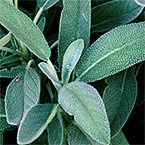Sage

On this page:
Introduction
This fact sheet provides basic information about sage—common names, what the science says, potential side effects and cautions, and resources for more information.
Sage has been used for centuries as a spice and seasoning in cooking and as a folk or traditional remedy for hoarseness, coughs, and sore mouths and throats. In ancient times it even was thought to extend life. Sage was used as a fertility drug in ancient Egypt. Physicians in ancient Greece used a solution of sage and water to stop wounds from bleeding and to clean sores and ulcers.
Today, sage is used as a folk or traditional remedy for mouth and throat inflammation, indigestion, and excessive sweating; to improve mood; and to boost memory or mental performance.
Sage is available as dried leaves, liquid extracts and sprays, and essential oils.
What the Science Says
- Sage has not been well studied as a treatment for sore throat, so there is little scientific evidence to support its use for that ailment.
- Two small studies suggest that sage may improve mood and mental performance in healthy young people and memory and attention in older adults. Results of another small clinical study suggest that a sage extract was better than placebo at enhancing thinking and learning in older adults with mild to moderate Alzheimer’s disease.
- Laboratory studies suggest that essential oils from sage may have antimicrobial properties.
Side Effects and Cautions
- Sage is generally regarded as safe by the U.S. Food and Drug Administration and is approved for food use as a spice or seasoning. However, some species of sage contain thujone, which can affect the nervous system. Extended use or taking large amounts of sage leaf or oil may result in restlessness, vomiting, vertigo, rapid heart rate, tremors, seizures, and kidney damage. It also may lead to wheezing. Ingesting 12 drops or more of the essential oil is considered a toxic dose.
- Drug interactions with sage have not been thoroughly studied.
- Sage can stimulate allergic or hypersensitivity reactions. Skin contact may result in inflammation. Ingesting sage powder or dust may cause breathing difficulties.
- Tell all your health care providers about any complementary health practices you use. Give them a full picture of what you do to manage your health. This will help ensure coordinated and safe care. For tips about talking with your health care providers about complementary and alternative medicine, see NCCAM's Time to Talk campaign.
Sources
- Bouaziz M, Yangui T, Sayadi S, et al. Disinfectant properties of essential oils from Salvia officinalis L. cultivated in Tunisia. Food and Chemical Toxicology. 2009;47(11):2755–2760.
- Kennedy DO, Pace S, Haskell C, et al. Effects of cholinesterase inhibiting sage (Salvia officinalis) on mood, anxiety and performance on a psychological stressor battery. Neuropsychopharmacology. 2006;31(4):845–852.
- Sage. Natural Medicines Comprehensive Database Web site. Accessed at www.naturaldatabase.com on May 24, 2010.
- Sage (Salvia officinalis, Salvia lavandulaefolia, Salvia lavandulifolia). Natural Standard Database Web Site. Accessed at www.naturalstandard.com on April 1, 2010.
- Sage Leaf. In: Blumenthal M, Goldberg A, Brinckman J, eds. Herbal Medicine: Expanded Commission E Monographs. Newton, MA: Lippincott Williams & Wilkins; 2000:330–334.
- Scholey AB, Tildesley NTJ, Ballard CG, et al. An extract of Salvia (sage) with anticholinesterase properties improves memory and attention in healthy older volunteers. Psychopharmacology. 2008;198(1):127–139.
For More Information
NCCAM Clearinghouse
The NCCAM Clearinghouse provides information on NCCAM and complementary health approaches, including publications and searches of Federal databases of scientific and medical literature. The Clearinghouse does not provide medical advice, treatment recommendations, or referrals to practitioners.
PubMed®
A service of the National Library of Medicine (NLM), PubMed® contains publication information and (in most cases) brief summaries of articles from scientific and medical journals.
Office of Dietary Supplements (ODS), National Institutes of Health (NIH)
ODS seeks to strengthen knowledge and understanding of dietary supplements by evaluating scientific information, supporting research, sharing research results, and educating the public. Its resources include publications (such as Dietary Supplements: What You Need to Know), fact sheets on a variety of specific supplement ingredients and products (such as vitamin D and multivitamin/mineral supplements), and the PubMed® Dietary Supplement Subset.
This publication is not copyrighted and is in the public domain. Duplication is encouraged.
* Note: PDF files require a viewer such as the free Adobe Reader.
